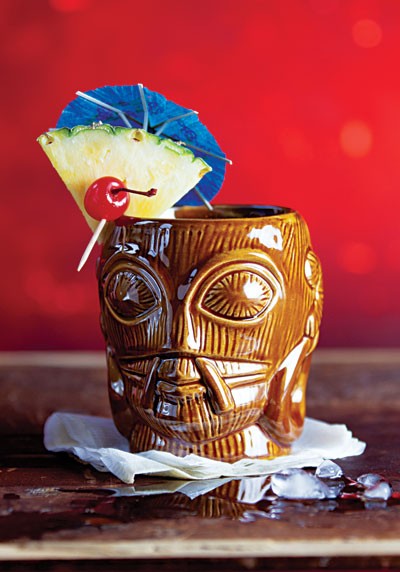Tiki cocktails make a comeback
August 7, 2015 by Darcie
Despite a reputation as a too-sweet libation served in kitschy goblets at chain restaurants, tiki drinks are serious cocktails. Originating in the 1930s in California, the boozy tropical beverages took hold during the 1950s and 60s before dropping off the cocktail radar. Thanks in part to retro shows like Mad Men, tiki drinks have staged an impressive comback. Eater.com traces the rise, fall, and resurgence of tiki cocktails.
Tiki was born in the midst of the Great Depression following the repeal of Prohibition. According to tiki historian Jeff “Beach Bum” Berry, one man can be credited for tikie culture: Don The Beachcomber, who came to Hollywood in 1934. Don–born Ernest Raymond Beaumont Gantt–wanted to share his love of Polynesia and opened a bar that featured artifacts he had collected during his travels.
The appeal of tiki to out-of-work and discouraged Americans was obvious. Says Berry: “[Tiki] works because it’s a mini-vacation. People were hungry for a fantasy, and what little disposable income they had went to trying to forget all that stuff. All eyes went to the South Pacific, perceived as a place of exotic abandon, where you didn’t have to work for a living. It was the exact opposite of being in a U.S. city in the winter of 1934.”
Even though tiki decor celebrates the tropics of Polynesia, the drinks owe more to the Carribean than the South Pacific. As much as Don The Beachcomber loved the region, cocktails really weren’t part of Polynesian culture. So he turned to another tropical location – the Carribean – and its rums, elevating the flavor fundamentals of rum, lime, and sugar with house-made syrups and fresh juices. Berry suggests that tiki drinks were the first craft cocktails post-Prohibition, describing them as “culinary-inspired cocktails that came more than seventy years before those terms existed.”
Photo of the Tiki bandit from Saveur Magazine
Categories
- All Posts (6940)
- Antipasto (2135)
- Author Articles (247)
- Book News (935)
- Cookbook Giveaways (983)
- Cookbook Lovers (257)
- Cooking Tips (109)
- Culinary News (299)
- Food Biz People (552)
- Food Online (791)
- Holidays & Celebrations (272)
- New Cookbooks (149)
- Recipes (1500)
- Shelf Life With Susie (231)
- What's New on EYB (133)
Archives
Latest Comments
- eliza on What foods do you look forward to the most for each season?
- kmwyman on Rooza by Nadiya Hussain – Cookbook Review and Giveaway
- Maryd8822 on The Golden Wok – Cookbook Giveaway
- Dendav on Danube Cookbook Review and Giveaway
- sanfrannative on Rooza by Nadiya Hussain – Cookbook Review and Giveaway
- darty on Danube Cookbook Review and Giveaway
- Atroyer7 on Danube Cookbook Review and Giveaway
- demomcook on What foods do you look forward to the most for each season?
- demomcook on Danube Cookbook Review and Giveaway
- Darcie on How cookbooks can help build resilience